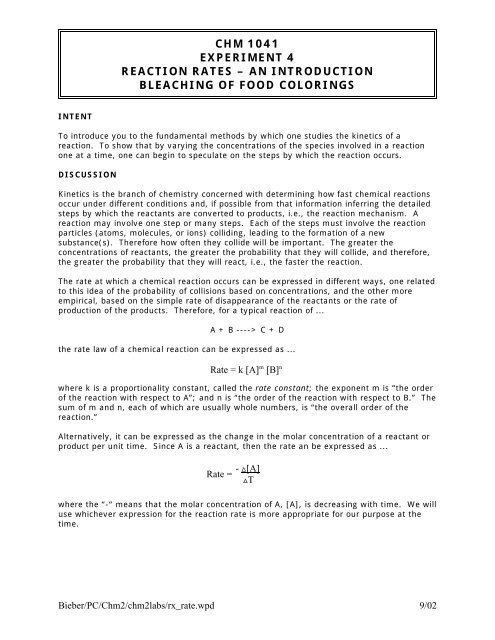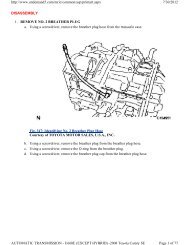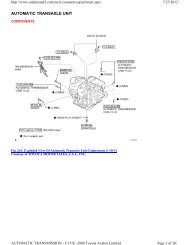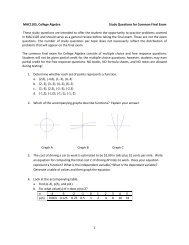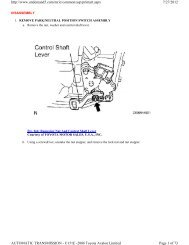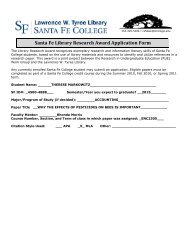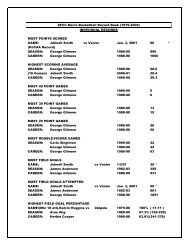CHM 1041 EXPERIMENT 4 REACTION RATES – AN ...
CHM 1041 EXPERIMENT 4 REACTION RATES – AN ...
CHM 1041 EXPERIMENT 4 REACTION RATES – AN ...
You also want an ePaper? Increase the reach of your titles
YUMPU automatically turns print PDFs into web optimized ePapers that Google loves.
INTENT<br />
<strong>CHM</strong> <strong>1041</strong><br />
<strong>EXPERIMENT</strong> 4<br />
<strong>REACTION</strong> <strong>RATES</strong> <strong>–</strong> <strong>AN</strong> INTRODUCTION<br />
BLEACHING OF FOOD COLORINGS<br />
To introduce you to the fundamental methods by which one studies the kinetics of a<br />
reaction. To show that by varying the concentrations of the species involved in a reaction<br />
one at a time, one can begin to speculate on the steps by which the reaction occurs.<br />
DISCUSSION<br />
Kinetics is the branch of chemistry concerned with determining how fast chemical reactions<br />
occur under different conditions and, if possible from that information inferring the detailed<br />
steps by which the reactants are converted to products, i.e., the reaction mechanism. A<br />
reaction may involve one step or many steps. Each of the steps must involve the reaction<br />
particles (atoms, molecules, or ions) colliding, leading to the formation of a new<br />
substance(s). Therefore how often they collide will be important. The greater the<br />
concentrations of reactants, the greater the probability that they will collide, and therefore,<br />
the greater the probability that they will react, i.e., the faster the reaction.<br />
The rate at which a chemical reaction occurs can be expressed in different ways, one related<br />
to this idea of the probability of collisions based on concentrations, and the other more<br />
empirical, based on the simple rate of disappearance of the reactants or the rate of<br />
production of the products. Therefore, for a typical reaction of ...<br />
A + B ----> C + D<br />
the rate law of a chemical reaction can be expressed as ...<br />
Rate = k [A] m [B] n<br />
where k is a proportionality constant, called the rate constant; the exponent m is “the order<br />
of the reaction with respect to A”; and n is “the order of the reaction with respect to B.” The<br />
sum of m and n, each of which are usually whole numbers, is “the overall order of the<br />
reaction.”<br />
Alternatively, it can be expressed as the change in the molar concentration of a reactant or<br />
product per unit time. Since A is a reactant, then the rate an be expressed as ...<br />
- ª[A]<br />
Rate = ªT<br />
where the “-“ means that the molar concentration of A, [A], is decreasing with time. We will<br />
use whichever expression for the reaction rate is more appropriate for our purpose at the<br />
time.<br />
Bieber/PC/Chm2/chm2labs/rx_rate.wpd 9/02
The concentration of the reactants is not the only factor which goes into determining the<br />
rate of a chemical reaction. A list of the factors includes:<br />
1. the concentrations of the reactants,<br />
2. the nature of the reactants,<br />
3. the temperature of the reactants, and<br />
4. the presence/absence of a catalyst.<br />
(where the amount of catalyst is often rate determining)<br />
As stated above, Factor 1 is related to the number of collisions. The second factor includes<br />
the fact that the reactants may likely need to come together in a specific orientation. That<br />
is, when reacting molecules collide there may only be one relative orientation of the<br />
molecules that leads to a reaction. Consider the reaction of IBr to Br 2 and I 2:<br />
Br<br />
I<br />
Br<br />
I<br />
2<br />
Br<br />
Br Br<br />
Br Br<br />
+<br />
I<br />
I I<br />
+<br />
I I<br />
+ +<br />
Br<br />
I<br />
2IBr ----> Br 2 + I 2<br />
If the molecules did not collide in the proper orientation shown, they would not be able to<br />
react.<br />
Factor 3 takes into account the energy that may be required to initiate a reaction (an<br />
activation energy) even if the overall reaction is exothermic. Since this energy comes from<br />
the kinetic energy of the reacting particles, the greater the average kinetic energy (i.e., the<br />
higher the temperature), the more high energy particles there are, and the more likely the<br />
reaction is to proceed.<br />
The fourth Factor, a catalyst, changes the mechanism (or the steps) of the reaction to one<br />
with a lower activation energy, and therefore without increasing the temperature, a greater<br />
fraction of the molecules will be able to react, because a greater fraction of the collision swill<br />
have enough energy to exceed the activation energy.<br />
Bieber/PC/Chm2/chm2labs/rx_rate.wpd 9/02<br />
I<br />
Br<br />
Br<br />
I
In the rate law the effect of Factors 2-4 are incorporated into k, the rate constant. For a<br />
given reaction the rate constant can vary, but only if the temperature is varied.<br />
In order to investigate the details of a reaction, kinetic studies which measure the rate of a<br />
reaction under different conditions are undertaken. Concentrations of the reactants,<br />
temperature of the reaction, and the addition of a catalyst can be used to gain insight into<br />
the individual steps of the reaction mechanism.<br />
3<br />
Bieber/PC/Chm2/chm2labs/rx_rate.wpd 9/02
Single-Step Reactions<br />
4<br />
If the entire reaction consists of one molecule of A colliding with one molecule of B, over and<br />
over again to form the product(s), then the one and only step of the reaction is ...<br />
1 A + 1 B ----> products<br />
One factor that determines how fast this reaction occurs would be the frequency of collision<br />
between a molecule of A and a molecule of B, i.e., the greater the likelihood of these<br />
collisions, the faster the reaction, all other things being equal. Since the probability of<br />
collision between A and B goes up (is directly proportional to) the concentration of each of<br />
the species, the rate of the reaction will depend on the [A] and [B] as in...<br />
Rate = k [A] 1 [B] 1<br />
where the exponents in the rate law are the same as the coefficients in the single step of the<br />
reaction (which is also the overall reaction).<br />
If the rate of the reaction is known for specific concentrations of A and B and at a specific<br />
temperature, then keeping everything the same except doubling the [A], results in doubling<br />
the number of collision between molecules of A and molecules of B; and therefore, the rate<br />
of the reaction would double. The same could be said for doubling [B].<br />
Multiple-Step Reactions<br />
Although the rate depends on the concentration of one or more reactants, it is not possible,<br />
in general, to tell from the overall stoichiometry of the reaction how a change in a given<br />
concentration will affect the rate. We saw that the rate can be determined from the<br />
stoichiometry, but only IF the reaction occurred in a single step. When a reaction occurs in<br />
more than one step there is often a slow step, the rate determining step, that will control<br />
the rate of the overall reaction. If the first step is the slow step then it will be straight<br />
forward to determine the rate law and the order of the reaction from the stoichiometry of<br />
that slow step. If however, the slow step is other than the first step, fitting the rate law to<br />
the steps is more complicated.<br />
For example, suppose that the second step of a multiple-step reaction is the slow step.<br />
Then the product, P 1, of the first step (a fast reaction) will accumulate because it is being<br />
produced quickly, but only used slowly. As a result, some of P 1, while its waiting to be used<br />
in the second step, can react to go back to the reactants of the first step.<br />
rapid slow<br />
A + B P 2 —> —> P final<br />
-----><br />
Hence, because the second step is slow there will be time for the first reaction to reverse<br />
and for that first step to reach a state of equilibrium. That is, the product of the first<br />
reaction will more quickly revert back to starting materials than it will react further to form<br />
the products of the second step. We will see such an example in this experiment<br />
Bieber/PC/Chm2/chm2labs/rx_rate.wpd 9/02
5<br />
In this experiment you will look at the rates of reaction of bleach with food coloring (dye) as<br />
a function of: (1) different food colorings, (2) changes in the concentrations of either the<br />
bleach or the dye, (3) changes in the temperature, and (4) changes in the bleaching<br />
reactant. You will study the bleaching of one food coloring in some detail, by varying one<br />
factor at a time<strong>–</strong>either one of he reactant concentrations or the temperature. Varying the<br />
concentration of a single reactant will allow you to determine the exponent on the<br />
concentration of that reactant in the rate law; and varying the temperature will allow you to<br />
determine the activation energy.<br />
In this experiment we will study:<br />
dye + bleach 6 products<br />
So, with respect to each reactant, the rate can be expressed as either the change in [dye]<br />
with time or the change in [bleach] with time, i.e., ª[dye]/ªtime or ª[bleach]/ªtime,<br />
respectively. We will always follow the progress of the reaction by observing the loss of<br />
color as the dye is bleached (oxidized) to form a light yellow product. Therefore, we will<br />
use....<br />
ª[dye]<br />
Rate = -<br />
ª(time)<br />
Since the overall reaction that we will examine is essentially irreversible, the initial reactants<br />
will not reform over the course of the reaction. We will measure the time for the “complete”<br />
reaction, as determined by eye from the loss of the dye color and convert it into an average<br />
rate over the course of the entire reaction. Since the overall reaction is not an equilibrium<br />
(i.e., it goes to completion), the average rate will be proportional to the initial rate.<br />
Even in those experiments where you are varying the concentration of the bleach, you will<br />
still be following the reaction by monitoring the change in the concentration of the dye, not<br />
the bleach. That is, we can use this expression whether we are varying the concentration of<br />
either the dye or the bleach or varying anything else for that matter.<br />
In this experiment the general form of the rate law becomes...<br />
Rate = k [bleach] m [dye] n<br />
where m and/or n will turn out to be either 0, 1, or 2.<br />
When you add drops of dye, the volume of each drop will not be identical. However, the<br />
variation in the drop volume from the same dropper will not affect the accuracy of your<br />
calculations. Since you are commonly working with two (2) significant figures and each<br />
drop will vary by less than 5%, the volume of “1 drop” can be considered accurate to 2 sig<br />
figs and treated as 1.0 drop, 2 drops can be treated as 2.0 drops, etc., in all of your<br />
calculations.<br />
Bieber/PC/Chm2/chm2labs/rx_rate.wpd 9/02
Techniques of Studying Kinetics<br />
R1<br />
R 2<br />
=<br />
6<br />
Determining the Order with Respect to a Reactant. Starting with Rate = k[A] m [B] n and one<br />
at a time, varying the concentration of one reactant, while keeping the concentration of the<br />
other reactant constant, will allow you to determine, one at a time, m and n, the order of<br />
the reaction with respect to [A] or [B]. For example, by running two experiments with<br />
different initial concentrations of A (while keeping the temperature and the concentration of<br />
B constant) you obtain two different rates, R 1 and R 2.<br />
Rate 1 = k[A 1] m [B] n<br />
A1] m<br />
] m<br />
A2 A2 ]<br />
[A1] =<br />
[<br />
[<br />
m<br />
[ A1] ]<br />
log<br />
[A<br />
(R 1<br />
1/R2) = log<br />
= m log<br />
[A2] [ A2 ]<br />
m =<br />
log<br />
Rate 2 = k[A 2] m [B] n<br />
You can determine m by first taking the ratio of the two rates, which gives...<br />
R 1 k[A 1] m [B] n<br />
rate ratio = =<br />
R 2 k[A 2] m [B] n<br />
Since neither the temperature nor [B] changed from one experiment to the other, both k<br />
and [B] n will be the same in the numerator and the denominator:<br />
Taking the logarithm of both sides will allow you to determine m:<br />
Solving for m gives ...<br />
log (R 1/R 2)<br />
A2 ] [A1]<br />
[<br />
Bieber/PC/Chm2/chm2labs/rx_rate.wpd 9/02<br />
[<br />
m
As shown here, we will sometimes use “R” (usually subscripted) for a rate. Do not confuse<br />
this with the gas constant, R, which is found in the Arrhenius equation. It should be clear<br />
form the context which R is meant.<br />
Determining the Value of n, the Order of the Reaction in Dye.<br />
7<br />
We could vary the dye concentration to determine the value of n, just as we will for the value of<br />
m, by maintaining a constant bleach concentration and varying the dye concentration. Instead we<br />
will use graphical analysis of the drop in dye concentration with time during the bleaching<br />
reaction to determine n.<br />
Analyzing the diminishing of the dye concentration during the reaction, while keeping the bleach<br />
concentration constant, will generate different types of linear graphs depending on the value of n.<br />
Specifically, if<br />
1. If the drop in dye concentration is linear with time, then the value of n is 0.<br />
2. If the drop in natural log (ln) of dye concentration is linear with time, then the value of n is 1.<br />
3. If the drop in the recipricol of the dye concentration is linear with time, then the value of n is<br />
2.<br />
See these graphs:<br />
Bieber/PC/Chm2/chm2labs/rx_rate.wpd 9/02
Determining the Activation Energy. The Arrhenius equation relates the rate constant<br />
with temperature and the activation energy. One form of the Arrhenius equation is ...<br />
ln (k 1/k 2)<br />
=<br />
Ea<br />
- +<br />
RT1<br />
Ea<br />
RT2<br />
8<br />
-E<br />
k = A C e a/RT<br />
where k is the rate constant; A, the frequency factor; Ea is the activation energy; R is the<br />
gas constant; and T is the kelvin temperature. The frequency factor, A, is a combination of<br />
a steric factor and a collision frequency so its value is approximately constant for a given<br />
reaction over small ranges in temperature. Since molecules move faster as the temperature<br />
increases, the collision frequency will also very slightly increase, but since it is already very<br />
high, the increase is insignificant.<br />
The activation energy can be obtained by a method similar to the one used before to find<br />
the order of the reaction. Run two reactions <strong>–</strong> this time varying only temperature, take a<br />
ratio of the rates (or a ratio of k’s), take the log, and rearrange to obtain the desired<br />
quantity. Taking the rate ration assuming that the two A’s are equal gives...<br />
k 1 -E a/RT 1 -E a/RT 1 +E a/RT 2 (-E a/RT 1 + E a/RT 2)<br />
= e = e C e = e<br />
k 2 -E a/RT 2<br />
e<br />
Taking the natural logarithm (ln) of each side gives...<br />
ln (R1/R2)<br />
=<br />
=<br />
T1<br />
1 1<br />
Since the Rate = k[A] m [B] n , and changing only the temperature changes only k. Therefore,<br />
R 1/R 2 (the two rates) can be substituted for k 1/k 2.<br />
Ea<br />
R<br />
Bieber/PC/Chm2/chm2labs/rx_rate.wpd 9/02<br />
E a<br />
R<br />
1 1<br />
-<br />
T 2<br />
T1<br />
-<br />
T 2
Then separating the ln term and converting ln to log gives...<br />
log (R1/R2)<br />
logR<br />
1<br />
log<br />
HALF-LIFE OF A <strong>REACTION</strong><br />
=<br />
R2<br />
Ea<br />
2. 303 R<br />
or<br />
=<br />
9<br />
1 1<br />
Bieber/PC/Chm2/chm2labs/rx_rate.wpd 9/02<br />
Ea<br />
2.303<br />
R<br />
T1<br />
-<br />
T1<br />
T2<br />
1 1<br />
Use of Spectrophotometer. Since one of the reactants is a dye we will be able to follow<br />
its reaction (disappearance) by spectrophotometer. You will measure the absorbency of 625<br />
nm light (the wavelength for maximum absorption by the blue dye in the visible region)<br />
after it passes through a solution fo the dye and bleach. Since 625 nm is in the orange<br />
portion of the spectrum, for the dye color you see it as white light minus orange; and the<br />
color appears blue.<br />
The measured absorbency will be directly proportional to the dye concentration. The<br />
proportionality constant between the two quantities incorporates two factors: how much<br />
solution the light passes through and how strongly the complex absorbs light at the single<br />
wavelength used. Both factors are constant in this spectrophotometer experiment. The<br />
amount of bleach available in this reaction compared to the small amount of dye reacted,<br />
also guarantees that the amount of bleach during the reaction is essentially constant, and<br />
only the dye changes significantly in concentration. In these measurements the bleach will<br />
be psuedo zero order. By measuring absorbency you are obtaining relative concentrations<br />
of the dye, where a decreasing absorbency corresponds to a decreasing concentration of the<br />
dye.<br />
You will use these values (each of which is proportional to an instantaneous concentration)<br />
that you have collected here to graphically determine the dye concentration dependency (n)<br />
and the rate constant of the reaction and its half-life* (a constant for the reaction and also<br />
independent of the actual concentration of dye if the reaction is first order or pseudo-first<br />
order) in questions1 and 2 at the end fo the lab.<br />
* Half-life = the time required for ½ of any sample to be consumed during a<br />
reaction, i.e., the time required for any sample to reduced to ½ of its original amount<br />
or concentration.<br />
-<br />
T 2
10<br />
First Order Reactions. First order reactions are unique in that the half-life of the reaction<br />
remains constant over the course of the reaction. We can determine a relationship between<br />
the half-life and the rate constant by equating the two different expressions for the rate<br />
which were given on the first page of this experiment. If a reaction is first order in only<br />
reactant, then ...<br />
ª[A] ª[A]<br />
= k[A] which rearranges to = -kªt<br />
ªT A<br />
If you consider the “ª’s” to be infinitesimally small changes, then you can use calculus to<br />
“integrate” this expression to give...<br />
ln [A] = -kt + ln[A] o<br />
where [A] o is the concentration at<br />
time = 0. Plotting ln [A] vs time gives a line with an intercept of “ln [A] o” and a slope of “k.”<br />
This equation can be rearranged to give ...<br />
t 1/2 =<br />
ln [A] - ln [A] o = -kt<br />
ln { [A] / [A] o} = -kt<br />
So that at the half life, when [A]/[A] o = ½ ; ln (½ ) = -ln 2 = -kt, or t 1/2 = (ln2)/k<br />
for a first order reaction.<br />
PROCEDURE<br />
0.693<br />
k<br />
You will prepare various mixtures of the dye and bleach. By varying the concentrations of<br />
first the bleach and then the dye you will be able to determine the order of the reaction with<br />
respect to each of these reactants. You will also follow the course of one bleaching process<br />
spectrophotometrically. Then you will run a series of identical reactions, but at different<br />
temperatures to see that affect of the activation energy. You will also see how the addition<br />
of a catalyst, hydronium ion, speeds up the reaction. In all of your experiments Erlenmeyer<br />
flasks, with their slanted sides, will be used to prevent any loss of your reaction mixture<br />
when you swirl your solutions to insure good mixing.<br />
Bieber/PC/Chm2/chm2labs/rx_rate.wpd 9/02
Name: Section:<br />
Date:<br />
11<br />
<strong>CHM</strong> <strong>1041</strong><br />
<strong>EXPERIMENT</strong> 4<br />
PRELIMINARY QUESTIONS (To be answered BEFORE coming to lab.)<br />
Examine a jug of chlorine bleach. What is the active ingredient?<br />
Based on your answer, what ions are present in large amounts in this aqueous solution?<br />
Are either of these two ions an aqueous acid?... a base??<br />
Explain:______________________________________________________________<br />
<strong>EXPERIMENT</strong>AL<br />
Nature of the Dye<br />
Since different chemicals react with oxidizing agents to varying degrees and at different<br />
rates, we will illustrate this be beaching two different dyes.<br />
To each of two 50 mL Erlenmeyer flask add 15.0 mL of 0.10M NaOH (aq) and 5.0 mL of<br />
concentrated (stock) bleach solution. We use 0.10M NaOH (aq) to maintain a near constant<br />
pH of the system. The pH which would change from run to run if deionized water alone was<br />
used to prepare different bleaching solutions. Swirl the flasks to mix the liquids. Once the<br />
solutions have been mixed, it is unnecessary to keep swirling when the reaction is at room<br />
temperature. Determine the temperature of one of these solutions. (Assume the other one<br />
has the same temperature.)<br />
T = BC<br />
To one of these flasks add one drop of the red dye solution while swirling it. (Swirling<br />
insures complete mixing.) Determine the time in seconds from the moment the drop hits<br />
the solution until the red color disappears (the pale yellow color of the bleach will still<br />
remain). Record the time.<br />
Time for red food coloring to react = s<br />
Take the other bleach solution and perform the same operation, only this time use one drop<br />
of the blue dye solution. Record the time and retain this solution.<br />
Time for blue food coloring to react = s<br />
This solution now contains the “completely bleached” blue dye. The remainder of this<br />
experiment will involve experiments that will allow you to determine the rate law for the<br />
Bieber/PC/Chm2/chm2labs/rx_rate.wpd 9/02
eaction of this blue dye with the bleach. The solution was kept to provide a color<br />
comparison to help you minimize inconsistencies in determining the end of each of the<br />
remaining reactions with the blue dye.<br />
12<br />
Bieber/PC/Chm2/chm2labs/rx_rate.wpd 9/02
13<br />
Varying the Bleach Concentration-Determining m<br />
Varying the concentration of the bleach while holding all other conditions constant will allow<br />
you to determine the value of m in the rate law:<br />
Rate = k [bleach] m [dye] n<br />
Prepare five (5) 0.10M NaOH (aq) diluted bleach solutions (exactly 20.0 mL each) in 50 mL<br />
Erlenmeyer flasks using the same concentrated bleach solution and 0.10M NaOH (aq) in the<br />
amounts listed in the table below and label each solution. Determine the temperature of the<br />
solution in Flask 5. (Assume all solutions are at the same temperature.) Read the next set<br />
of directions to get ready to use the Spectronic 20 spectrophotometer to measure the times<br />
needed to bleach your blue dye in 0.10M NaOH (aq) solutions.<br />
T = + 0.1°C<br />
You will start measuring the bleach time as soon as you add your drop of blue dye to your<br />
bleach in 0.10M NaOH (aq) solutions, and time until the color is bleached out equal to your<br />
standard.<br />
To one solution at a time, add one drop of blue dye while swirling the flask and immediately<br />
begin measuring the time, to the nearest second, required to bleach the blue dye. Record<br />
the reaction time in the table below.<br />
Bieber/PC/Chm2/chm2labs/rx_rate.wpd 9/02
Run Volume of<br />
Bleach Sol’n<br />
Volume<br />
of 0.10M<br />
NaOH<br />
(aq)<br />
14<br />
Relative<br />
Bleach Conc.<br />
Reaction Time (ªt) Relative Rate<br />
-ª[dye]/ªtime**or<br />
(1/time)<br />
1 2.0 mL 18.0 mL 1.0 s x 10 -2<br />
2 4.0 mL 16.0 mL 2.0 s x 10 -2<br />
3 5.0 mL 15.0 mL 2.5 s x 10 -2<br />
4 8.0 mL 12.0 mL 4.0 s x 10 -2<br />
5 10.0 mL 10.0 mL 5.0 s x 10 -2<br />
** To calculate a rate for each run you must know how the [dye] changes. Since change is always<br />
FINAL state minus INITIAL state, the negative of the change, -ª[dye], is [dye] initial - [dye] final.<br />
Therefore, with the final concentration of dye being essentially zero, -ª[dye], is [dye] initial . The<br />
initial concentration of dye is the same fur Runs 1-5. However, its actual values is unknown.<br />
Without this knowledge we will not be able to get absolute rates from this experiment, only<br />
“relative rates.”<br />
Since we will take ratios, relative rates will be sufficient. (That is, a ratio of relative rates is<br />
the same as a ratio of exact rates.) We can assume any value for the initial concentration of<br />
the dye that is convenient. We will assume a value equal to the number of drops of dye.<br />
Calculate and record that “relative rates,” not as a fraction, but as some number “ x 10 -2 ”<br />
Because of inconsistencies in determining the end of each reaction it will be necessary to<br />
determine an average value of m using all of these relative rates, rather than just<br />
comparing two relative rates. However, you can get an approximate value of m by<br />
comparing just two relative rates.<br />
The only difference between Run 1 and Run 2 was that the concentration of the bleach was<br />
double in Run 2. As a result of this doubled concentration, the rate of Run 2 is<br />
approximately<br />
(the same as, double, or quadruple) the rate of Run 1 and a<br />
tentative value of m = (0, 1, or 2) can be assigned. In the same way you could<br />
also compare Run 2 with Run 4 or Run 3 with Run 5.<br />
Bieber/PC/Chm2/chm2labs/rx_rate.wpd 9/02
Run<br />
Ratio<br />
15<br />
As a way to average out any errors in determining the end of each reaction, we will make<br />
many, different comparisons between the rates of the reactions. Averaging will help<br />
eliminate errors in individual measurements. This is what you are doing when you calculate<br />
the ratios of relative rates and ratios of relative bleach concentrations for the Runs indicated<br />
in the table below. When you then calculate values of m and average your answers, small<br />
errors should average out.<br />
Relative Rate<br />
Ratio (R*)<br />
Relative Bleach<br />
Concentration Ratio (C*)<br />
1/3 1.0/2.5 = 0.40<br />
2/4<br />
3/5<br />
4/1<br />
5/2<br />
Bieber/PC/Chm2/chm2labs/rx_rate.wpd 9/02<br />
OK<br />
log R*<br />
log C*<br />
Calculate an average value of m Assuming that m is a whole number, the value (either<br />
0, 1, or 2) of m =<br />
= m
16<br />
Based on your experimental results, complete the rate law, thus far, for this reaction using OCl 1for<br />
bleach:<br />
Rate = k<br />
Determininging the Order of the Dye Concentration in the Rate Law-Determining n<br />
Varying the concentration of the bleach, while holding all other conditions constant, should<br />
have led you to this conclusion for your rate law with respect to bleach:<br />
Rate = k [bleach] 1<br />
Now we will determine the value of n in the rate law by graphical analysis.<br />
Rate = k [bleach] 1 [dye] n<br />
Mix 2.0 mL of bleach solution and 18.0 mL of 0.10M NaOH (aq) in a 50 mL Erlenmeyer flask<br />
(as done in Run 1).<br />
Using Spectrophotometer to Follow the Extent of the Reaction<br />
By determining the concentration of the dye as a function of time we will be able to<br />
determine the half-life of the reaction with respect to the dye and the rate constant for the<br />
reaction. It will also give us an alternative method of determining the order of the reaction<br />
with respect to the dye.<br />
Obtain one of the spectrophotometer tubes (cuvettes) from the stockroom to use in the<br />
spectrophotometer. Handle it carefully; cuvettes are expensive and easily damaged. Use<br />
them only in the spectrophotometer and return them to the stockroom at the end of<br />
the period. Clean and dry the cuvette with a soft tissue.<br />
Now zero the spectrophotometer according to the following directions. (The<br />
spectrophotometer should have been warming up for at least 30 minutes before use.) The<br />
following four-step instructions apply specifically to the Spectronic 20. (Some of these<br />
steps may have already been done for you; consult your instructor.)<br />
1. Check the wavelength selector for the correct setting (625 nm).<br />
2. With the cell compartment empty, use the knob on the left front to adjust the<br />
meter to read 0% transmission (4 absorbency).<br />
3. Put a cuvette filled with 0.10M NaOH(aq) into the cell compartment, aligning<br />
the mark or label on the tube with the mark at the front of the cell<br />
compartment. This is a reference solution or “blank.” Use the knob on the<br />
right front to adjust the meter to read 100% transmission (zero absorbency).<br />
4. Remove the reference tube. If the meter does not read 0% transmission go<br />
back to Step 2 and continue to repeat the steps until the meter does read 0%<br />
after removing the blank.<br />
Bieber/PC/Chm2/chm2labs/rx_rate.wpd 9/02<br />
OK
17<br />
Prepare to use a clean, dry cuvette (or rinse a wet cuvette, previously used, with a small<br />
amount of 0.10M NaOH (aq), and drain the cuvette into a waste container. Add two (2)<br />
drops of blue dye, swirl the flask, and quickly transfer enough of this solution to nearly fill<br />
your waiting cuvette Quickly dry the outside of the cuvette again, if necessary, handling it<br />
only by the rim to avoid getting fingerprints on the surface of the tube. Now insert the<br />
cuvette into the spectrophotometer’s sample holder. Start recording the absorbency when<br />
it has a value of 1.00. Record your readings of the absorbency (to as many sig figs as<br />
possible) every ten (10) seconds for a total of 150 seconds. This will give you a convenient<br />
starting value later for log of the absorbency, namely 0.000. The actual value of absorbency<br />
when you mix the solutions is not important-only how the value changes with time.<br />
Bieber/PC/Chm2/chm2labs/rx_rate.wpd 9/02
Elapsed<br />
Time<br />
Absorbency<br />
Reading<br />
18<br />
Log 10 of the<br />
Absorbency Reading<br />
1/Absorbency<br />
Reading<br />
0 s 1.00 0.000 1.000<br />
10 s<br />
20 s<br />
30 s<br />
40 s<br />
50 s<br />
60 s<br />
70 s<br />
80 s<br />
90 s<br />
100 s<br />
110 s<br />
120 s<br />
130 s<br />
140 s<br />
150 s<br />
Later calculate the log 10 of the absorbency and 1/absorbency and record them in the table.<br />
Your graphs of these three functions should allow you to choose the exponent of the dye<br />
term, n. You will use these values (each of which is proportional to an instantaneous<br />
concentration) that you have collected here to graphically determine the rate constant of the<br />
reaction and its half-life in Questions 1 and 2 at the end of the lab.<br />
Varying the Temperature<strong>–</strong>Determining E a<br />
To test the effect of temperature upon the rate of reaction, prepare four identical solutions<br />
in 50 mL Erlenmeyer flasks, each with 10.0 mL of concentrated bleach solution and 10.0 mL<br />
of 0.10M NaOH (aq). Mix the solutions by swirling. Number them 10-13. Set up your own<br />
ice-water bath to pre-chill the diluted bleach solutions to approximately the temperatures<br />
indicated in the table below. As they become available, place each solutions, one at a time,<br />
in the appropriate water bath (adding ice to the baths, as necessary, to maintain the<br />
temperature of the bath<strong>–</strong>check with a thermometer in the bath). Place a thermometer in<br />
your reaction flask and swirl the flask to achieve good mixing. Do NOT stir the solution with<br />
the thermometer. When the temperature of each reaction mixture becomes constant at the<br />
desired value (when it’s thermostated), record the actual temperature in the flask. You will<br />
maintain this temperature during the reaction by holding your flask in the bath as the<br />
reaction occurs in each solution. Begin swirling your flask in the water bath and add one<br />
drop of blue food coloring to the solution. Continue to swirl the flask; and record the time<br />
that it takes to completely bleach the blue dye. Repeat the process with the remaining<br />
Bieber/PC/Chm2/chm2labs/rx_rate.wpd 9/02
flasks.<br />
19<br />
Run Approx. Temp Actual Temp. Rxn Time<br />
5 RT °C s<br />
10 20°C °C s<br />
11 15°C °C s<br />
12 10°C °C s<br />
13 5°C °C s<br />
Again, - ª[dye] = + [dye] initial and the same for all runs in this section. Take the value to<br />
be 1.0, the number of drops, in Runs 10-13, as you did in Run 5.<br />
Run Actual Reaction<br />
Temp.<br />
Reaction<br />
Time (ªt)<br />
Relative Rate<br />
-ª[dye]/ªtime<br />
5 °C = K s x 10 -2<br />
10 °C = K s x 10 -2<br />
11 °C = K s x 10 -2<br />
12 °C = K s x 10 -2<br />
13 °C = K s x 10 -2<br />
Log of the<br />
Relative<br />
Rate<br />
Reciprocal<br />
of Temp.<br />
1/K<br />
You will use the data that you have obtained here to graphically determine the activation<br />
energy in Question 3 at the end of the lab.<br />
Bieber/PC/Chm2/chm2labs/rx_rate.wpd 9/02
Adding Additional Catalyst<br />
20<br />
Just as you saw a different reaction rate when a different dye (red vs blue) was bleached,<br />
changing the bleach can also change the rate. Adding H 3O 1+ can change the bleach into a<br />
much stronger beaching agent by converting OCl 1- into HOCl. Adding H 3O 1+ can also change<br />
the dye into a substance which can be more easily attacked by the bleach. There is a small<br />
amount of H 3O 1+ present in the stock bleach solution to act as a catalyst<strong>–</strong>you will be adding<br />
more H 3O 1+ . (Adding H 3O 1+ may also produce some Cl 2, which is also a stronger bleach than<br />
either OCl 1- or HOCl.)<br />
Use five 50 mL flasks to prepare identical solutions for Runs 14-18. Add 5.0 mL of bleach<br />
solution and 15.0 mL of deionized water to each. (Using 0.10M NaOH (aq) here would only<br />
consume the acid we will add and block its effects.)Then add the indicated number (see<br />
table below) or drops of 3 M HCl(aq) to each flask. Add 1 drop of dye to each solution, one<br />
solution at a time while swirling, and measure the time to decolorize (to yellow) the blue<br />
dye solution. Record each time of reaction.<br />
Run<br />
Drops of<br />
3 MHCl Reaction Time<br />
14 0 s<br />
15 1 s<br />
16 2 s<br />
17 3 s<br />
18 5 s<br />
You earlier wrote an expression of the rate law which did not consider what you have just<br />
seen regarding the affect on the rate of added H 3O 1+ .<br />
In light of these observations, modify your previous rate law to include the affect of added<br />
acid. (Since you don’t know the order of the reaction with respect to H 3O + , use a variable as<br />
the exponent on [H 3O 1+ ].)<br />
Bieber/PC/Chm2/chm2labs/rx_rate.wpd 9/02
QUESTIONS <strong>AN</strong>D PROBLEMS<br />
21<br />
The abosrbance that you observed shows how the concentration of one of the reactants (the<br />
dye) decreased as a function of time. Plot the absorbency data on the first of three graphs.<br />
Plot the absorbency (in the y axis) vs time (on the x axis), then the log of the absorbency vs<br />
time, then the reciprocal of the absorbency vs time. Plot each datum point and circle it.<br />
Draw a single, smooth curve that closely matches all of the points. However, for one of<br />
these plots you should be able to draw a straight line (use a ruler) from the data<br />
points.<br />
1. Order of the Dye (n): If the plot of absorbency vs time is linear, then the reaction<br />
is order in dye. If the plot of log of the absorbency vs time is linear,<br />
then the reaction is order dye. If the plot of the reciprocal of the<br />
absorbency vs time is linear, then the reaction is<br />
order in dye.<br />
2. Half-life Time (T 1/2): On the smooth curve of absorbency vs time...<br />
a. Select points (write the coordinates next to each point) which correspond<br />
to absorbency (concentration) halvings to determine several half-lives of this<br />
reaction. List the points used and the half-lives determined.<br />
Concentration Time<br />
From To From To Half-life<br />
b. If this reaction is first order in dye you should have obtained half-lives that<br />
are approximately constant. Is this reaction first order in dye based on these<br />
absorbency halvings from the plot of absorbency vs time, yes or no?<br />
Bieber/PC/Chm2/chm2labs/rx_rate.wpd 9/02
c. Show the calculation of the average half-life from your data above.<br />
Calcs.:<br />
22<br />
Best value of half-life is s<br />
d. Show the calculation of the rate constant from the half-life.<br />
Calcs.:<br />
Rate constant calculated from your half-life is s -1<br />
3. The plot which yields a straight line is the plot of vs time.<br />
a. Therefore, this is a order reaction in dye; and the slope is<br />
equal to .<br />
b. Determine the slope of this line from two selected points. Write the<br />
coordinates next those points on your graph and below.<br />
The slope is<br />
c. Show the calculation of the rate constant (k) for this reaction from the slope.<br />
Calcs.:<br />
The slope gives a rate constant of s -1<br />
Bieber/PC/Chm2/chm2labs/rx_rate.wpd 9/02
log<br />
=<br />
23<br />
4. Use the final graph to plot the log of the relative rate (on the y axis) vs the reciprocal<br />
of the temperature, 1/K, (on the x axis)<strong>–</strong>an Arrhenius plot. Plot each datum point<br />
and circle it. Use a ruler to draw one straight line which best fits all of the<br />
data points.<br />
Pick two convenient points on your straight line (do not use actual data<br />
points<strong>–</strong>write the coordinates next to the points), and calculate the activation<br />
energy for this reaction from the equation:<br />
log R1<br />
R 2<br />
2.303<br />
1 1<br />
where R is the gas constant (8.3145 J CK -1 C mole -1 ); and R 1 and R 2 are the two<br />
relative rates that you selected; and as always, temperature is in kelvins.<br />
Bieber/PC/Chm2/chm2labs/rx_rate.wpd 9/02<br />
Ea<br />
R<br />
T 1<br />
E a = kJ C mole -1<br />
5. for the reaction that you have studied here, assume the net stoichiometric reaction<br />
can be represented by ...<br />
Dye + OCl 1- 6 Cl 1- + O-dye<br />
where O-dye represents the decolorized (oxidized) form of the dye (food coloring).<br />
a. Given below are three mechanisms that you are to consider for this reaction.<br />
Determine whether one or more of them is/are consistent with all of your<br />
observations, including the rate enhancement seen with the addition of strong<br />
acid. Show your reasoning.<br />
A. OCl 1- + dye 6 ClO-dye 1-<br />
ClO-dye 1- 6 Cl 1- + O-dye (fast)<br />
(slow)<br />
B. OCl 1- + H3O 1+ W HOCl + H2O(fast) HOCl + dye 6 HO-dye 1+ + Cl 1-<br />
HO-dye 1+ + H2O 6 O-dye + H3O 1+<br />
(slow)<br />
(fast)<br />
C. dye + H 3O 1+ W dye-H 1+ + H 2O (fast)<br />
dye-H 1+ + OCl 1- 6 O-dye-H 1+ + Cl 1- (slow)<br />
O-dye-H 1+ + H 2O 6 O-dye + H 3O 1+ (fast)<br />
b. If you have determined more than one consistent mechanism, suggest<br />
additional experiments that might support one mechanism over another.<br />
-<br />
T2


